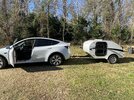Something like that could always be hard wired in.
I've always wondered if when the tesla is "off" and unplugged if it still tops off its 12v battery from its big battery when the 12v battery runs low. If that were true then it would definitely be possible to run wires directly from the Tesla 12v battery contacts to be used for the camper power (or for topping off the camper battery).
I've always wondered if when the tesla is "off" and unplugged if it still tops off its 12v battery from its big battery when the 12v battery runs low. If that were true then it would definitely be possible to run wires directly from the Tesla 12v battery contacts to be used for the camper power (or for topping off the camper battery).





